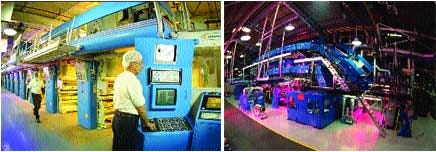Alcoa commits to blister-back converting
January 29, 2014
Spring, the season of renewal, has arrived a little early at Alcoa Flexible Packaging's Downingtown, PA, plant. Here, the company is getting a jump on the new season and on competitors by inaugurating its pharmaceutical packaging center, a plant-in-a-plant, dedicated to blister-backing web structures converted under optimal conditions for a fast-emerging market segment.
Within a 200,000-sq-ft manufacturing space acquired from Reynolds Metals, the segregated facility–encompassing about 25 percent of the plant's space–will focus on conversions using its Drug-Pak® hard foil-based material for push-through applications and its Safety-Pak® paper/film/foil structure for child-resistant peel-and-push backing specifications.
Through installation of new equipment and meticulous production procedures, both materials are converted under conditions that "will enable Alcoa to drastically shrink its lead time," pharmaceutical operations manager P.J. Cormier tells PD during a visit last month.
An environment that complies with Current Good Manufacturing Practices, the manufacturing area will contain converting and secondary operations in a tightly controlled setting. Even raw materials will be warehoused within its confines.
Christmas present
Undoubtedly the showpiece of the center is a new rotogravure press, which was in production shortly after Christmas. The press, a Rotomec Rotopac 4000-2, is the first of its type to be installed in the U.S., reports Valmet Rotomec sales manager Marco Lubrano, present in Downingtown during PD's stay. The multistation, wide-web press is rated to 1,000 ft/min even with the gravure wet-bond laminator/coater that comprises one of its stations, enabling Alcoa to convert both materials on the same machine.
Accounting for this level of output are several factors. Accurate working and balancing of rotating parts is accompanied by the use of quick-change impression sleeves. Drying time is reduced by high-efficiency ovens on the mezzanine level.
The press also eliminates compensation rollers, replacing them with an electronic shaft that results in a reduction of up to 20 percent in web passage. Finally, one feature that especially pleases Cormier is easy replacement of print cylinders, pressure roller sleeves and cartridges between the side frames. "It really takes a strain off of the people working on the equipment," he notes, "and reduces makeready time."
Controls all over
Helping the press to reach its rated speed with no loss to printing quality are controls and counterchecks. Under the command of a Siemens programmable logic controller, the press is fitted with Eltromat's DGC 650 register control, specifically designed for rotary gravure applications. Along with its conventional web/cylinder and two-channel web/web measurement, the digital system also offers a unique single-head web/web measurement function for registration marks. "And," Cormier says, "it saves registration recipes, which in turn saves us time."
Process control is assured through the line-side automatic print-defect detection system, Advanced Vision Technology's Print/Vision Genesis system. At the console, the interface screens pick up such defects as misregistration, color variations, and smears, spots, streaks, splashes and misprints. It feeds out roll reports as the press runs, especially critical following the laminator/coater station.
|
At the top of the multicolor, wide-web press, above left, functions are monitored by register controls plus line-side print defect detection. Safety-Pak laminations are manaufactured on Alcoa's Triplex laminator at its Bellwood Printing Plant, a primary focal point within another planned pharmaceutical center. |
After a setup time of less than 30 minutes, the Genesis freezes the image of a detected defect on a screen, and a red alert is triggered. The defect is marked and classified, enabling the operator to determine its cause quickly–and fix it.
Cormier acknowledges some redundancy in the inspection systems. "However," he argues, "we feel this is one of the reasons we were able to be off and running with superior webs so quickly after the press was installed." He rejects the adage regarding too much of a good thing.
Isolated activities
Still within the confines of the pharmaceutical center are two additional, dedicated 10-color gravure presses for narrow-web printing. Both built by Chesnut Engineering, the veterans give Alcoa considerable added capacity and scheduling flexibility.
One is the Model 150, which, installed in the late '80s, prints a 15-in.-W web. The more recent is Chesnut's Model 300, which prints up to a 20-in.-W web. Neither shows signs of flagging as demands rise in the center.
In a separate room still within the center, an array of secondary processing equipment includes a Stanford Products Model 338 slitter/rewinder and four Model 152HD extractor/splicers. This latter model is also known as the Stanford Doctor Machine® and is built with a reversible rewind.
Reviewing the content and format of the pharmaceutical center, Alcoa pharmaceutical marketing manager Bill Nelson tells PD: "We've gone to great efforts to bring together the best and highest-proficiency equipment now available. Along with improved scheduling and delivery, the machines give us greater running time than we've ever had.
"We've been working three shifts and most weekends since the start of the year. We expect the center to have a strong, positive impact on the market."
Right now, the people at the Downingtown plant have their own hard running to do. The pharmaceutical center will have its official opening next month.
More information is available:
Materials: Alcoa Flexible Packaging, 804/281-2262. Circle No. 221.
Rotomec press/laminator: Valmet Converting, 704/587-2415. Circle No. 222.
PLC: Siemens Energy & Automation,513/841-3322. Circle No. 223.
Register control: Eltromat, 757/487-3819. Circle No. 224.
Defect detection system: Advanced Vision Technology, 770/541-9780. Circle No. 225.
Presses: Chesnut Engineering, 973/227-6995. Circle No. 226.
Slitter/rewinder, extractor/splicer: Stanford Products, 618/548-2600. Circle No. 227.
About the Author(s)
You May Also Like



